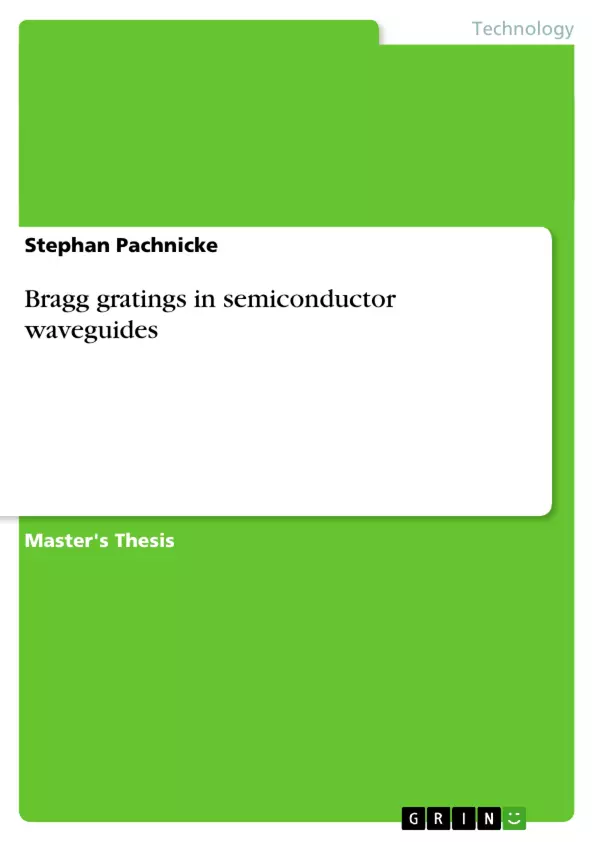Bragg gratings are important devices for both optical communications and
sensing. These devices are used to design very narrow band optical filters, which can
be used in wavelength division multiplexing (WDM). It is also perceived that Bragg
gratings will be used to compensate the dispersion in modern fibre optic
telecommunication networks. Semiconductor gratings are usually integrated into
lasers to control the operating wavelength.
City University Photonic Modelling Group is a world leading research group on
the use of rigorous numerical techniques to design and optimise advanced photonic
devices for optical communications. The research group has already achieved results
on hypothetical one-dimensional (1-D) and realistic two-dimensional (2-D)
structures. In this project a combination of three numerical methods has been used,
all of which are rigorous, to simulate realistic three-dimensional (3-D) structures in
semiconductor waveguides. The combination of these three accurate methods, the
finite element method (FEM), the least squares boundary residual (LSBR) method
and the transfer matrix method (TMM) turned out to be superior to the widely used
coupled mode theory (CMT).
The numerical study of different Bragg gratings shows interesting dependencies
of the characteristics of the gratings on the different design parameters. The work
was carried out for different mesh distributions, different numbers of mesh divisions
and different computational parameters. Another focus of the work was on the
stability of the transmission and reflection coefficients obtained from the LSBR
program. Furthermore the effect of inaccuracy occurring during the fabrication
process has been studied.
The results of this work have been compared to results found by other groups and
fellows. We can say that this project is quite new in the field of reflection spectrum
computation of realistic 3-D semiconductor Bragg gratings. Up to now only a few
papers have been published on such 3-D semiconductor gratings.
Inhaltsverzeichnis (Table of Contents)
- 1 INTRODUCTION
- 1.1 Introduction
- 1.2 Optical communication systems
- 1.3 Aims and objectives
- 1.3.1 Previous works
- 1.3.2 Work in this project
- 1.4 Structure of this thesis
- 2 THEORY
- 2.1 Chapter overview
- 2.2 Maxwell's equations
- 2.3 Boundary conditions
- 2.4 Reflection and refraction
- 2.5 Dispersion and loss
- 3 DIFFERENT TYPES OF BRAGG GRATINGS
- 3.1 Chapter overview
- 3.2 Principle of operation
- 3.2.1 Uniform gratings
- 3.2.2 Chirped gratings
- 3.2.3 Apodised grating
- 3.2.4 Phase-shifted gratings
- 3.2.5 Multiple gratings
- 3.3 Applications of Bragg gratings
- 3.3.1 Demultiplexer in WDM systems
- 3.3.2 Dispersion compensation
- 3.3.3 Applications in lasers
- 3.3.4 Applications in sensing technology
- 3.4 Fabrication of Bragg gratings
- 3.4.1 Fabrication of fibre Bragg gratings
- 3.4.2 Fabrication of semiconductor Bragg gratings
- 4 SIMULATION METHODS
- 4.1 Chapter overview
- 4.1.1 Introduction
- 4.1.2 Theory of the FEM
- 4.2 Least squares boundary residual (LSBR) method
- 4.2.1 Introduction
- 4.2.2 Theory
- 4.3 Transfer matrix method (TMM)
- 4.3.1 Introduction
- 4.3.2 Theory for uniform gratings
- 4.3.3 Theory for apodised gratings
- 4.4 Overlap integral (OI)
- 4.5 Coupled mode theory (CMT)
- 4.5.1 Introduction
- 4.5.2 Theory
- 5 SIMULATION RESULTS
- 5.1 Chapter overview
- 5.2 Examined structures
- 5.3 Results obtained from FEM
- 5.4 Analysis of the discontinuity junction using LSBR
- 5.5 Simulation of a complete grating using TMM
- 5.5.1 Introduction
- 5.5.2 Input data
- 5.5.3 Uniform gratings
- 5.6 Results obtained from the CMT
- 5.7 Simulation of fabrication inaccuracy
- 5.8 Apodised gratings
- 5.8.1 Different apodisation profiles
- 5.8.2 Simulation results
- 5.9 Chirped gratings
- 5.10 Phase-shifted gratings
- 5.11 Multiple gratings
Zielsetzung und Themenschwerpunkte (Objectives and Key Themes)
This thesis investigates the design, analysis, and fabrication of Bragg gratings in semiconductor waveguides. The work aims to develop a comprehensive understanding of Bragg gratings, explore various types and their applications, and evaluate different simulation methods for their design and analysis. The research focuses on advancing the knowledge and implementation of Bragg gratings in semiconductor waveguides for applications in optical communication systems.
- Theoretical understanding of Bragg gratings in semiconductor waveguides
- Exploration of different types of Bragg gratings (uniform, chirped, apodised, phase-shifted, multiple)
- Analysis of simulation methods for design and analysis of Bragg gratings (FEM, LSBR, TMM, CMT)
- Simulation and analysis of fabrication inaccuracies and their impact on grating performance
- Applications of Bragg gratings in optical communication systems (demultiplexing, dispersion compensation, lasers)
Zusammenfassung der Kapitel (Chapter Summaries)
The first chapter provides an introduction to optical communication systems, Bragg gratings, and the objectives of the thesis. Chapter 2 reviews the relevant theoretical concepts, including Maxwell's equations, boundary conditions, reflection, refraction, dispersion, and loss. Chapter 3 explores different types of Bragg gratings, their principles of operation, and various applications. The fourth chapter focuses on simulation methods, discussing the finite element method (FEM), the least squares boundary residual (LSBR) method, the transfer matrix method (TMM), and the coupled mode theory (CMT). Chapter 5 presents simulation results obtained using these methods, examining the performance of different Bragg grating designs. This chapter also analyzes fabrication inaccuracies and their effects on grating performance.
Schlüsselwörter (Keywords)
Bragg gratings, semiconductor waveguides, optical communication systems, demultiplexing, dispersion compensation, simulation methods, finite element method, LSBR, transfer matrix method, coupled mode theory, fabrication inaccuracy, apodised gratings, chirped gratings, phase-shifted gratings, multiple gratings.
- Arbeit zitieren
- Dr.-Ing. Stephan Pachnicke (Autor:in), 2001, Bragg gratings in semiconductor waveguides, München, GRIN Verlag, https://www.hausarbeiten.de/document/50382


